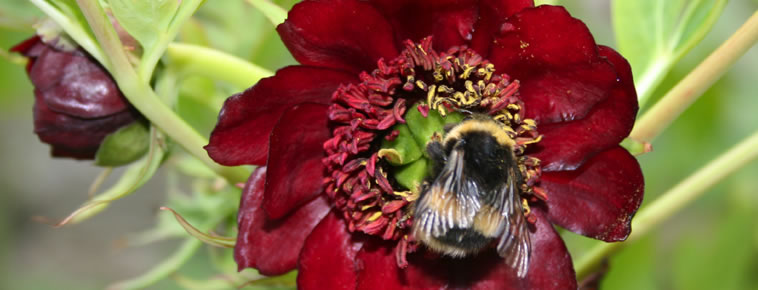
MAY AT CLUNY
May is reckoned to be Cluny’s most glorious month. There are many plants in bloom and the wild bluebells add to the ambience as do the fantastic scents and wonderful birdsong. Cluny is a peaceful place so take your time going around and enjoy the atmosphere. You will notice since Storm Arwen in November 2021, a few fallen trees remain as features and providing habitat for wildlife.
PRIMULAS
The first candelabra primulas flower in early May. The most prolific and found growing even in the gravel, is the orange-yellow P. chungensis. Slightly later comes the majestic purple P. pulverulenta along with naturally occurring hybrids of both primulas in orange, pink and pale purple. By the middle of the month P. japonica (crimson) and P. bulleyana (orange) are beginning to appear while smaller primulas, often beautifully scented, including munroi (3 forms), waltonii, ioessa, alpicola, palmata and latisecta flower in profusion from mid-May onwards. Examples of these and other plants are also in pots on the gravel.
BULBS & TUBERS
There are approximately 18 varieties of white, red or maroon Trilliums (Wake Robin, Wood Lily) in the garden easily recognised by their 3 leaves, 3 sepals and 3 petals. In early May there is a striking double form, small clumps are positioned throughout. All Trilliums take many years to reach the large clump sizes you will see here. Stalks of last year’s Cardiocrinum giganteum (giant Himalayan Lily) can still be seen with their Venus Flytrap-like seed heads. The stalks of the bulbs to flower this year are already growing quickly and have large glossy greeny-brown heart-shaped leaves. You will see many at different age stages between nos 2 & 3.
MECONOPSIS - HIMALAYAN POPPIES
The larger flowered species borne on single stalks in a rich blue is Meconopsis grandis and its hybrids which begin flowering in early May. Later, M. baileyi (formerly betonicifolia) with its beautiful nodding heads in various hues of blue, and also pure white, grows happily in deep leaf mould throughout the garden. In early May, delicate dusky pink Meconopsis x cookei flower in pots on the gravel.
TREES & SHRUBS
There are many gloriously scented ornamental apples and cherries all over the garden. Look out for Prunus serrula tibetica (Tibetan cherry) with its red peeling bark. Adding to the scents, are numerous lilacs (Syringa) and azaleas. Many rhododendrons & azaleas bloom in May along with the closely related Enkianthus, which bears pendant racemes of mainly pink bell-shaped flowers. The acers (Japanese Maples) with their beautiful fresh green leaves have small but delicate flowers while glorious Magnolias (M. wilsonii overlooks the entrance panel) and Tree Paeonias (P. delavayi) grow well in the shelter of the house. The striking climber Actinidia kolomitka with its variegated green, white and pink leaves grows on the far end of the house wall. Various species of Clematis can be found sprawling over shrubs throughout the garden.
AND THE REST!
There are of course lots of other plants to enjoy but some favourites include the Actaeas (Baneberry), Geraniums, Thalictrums (meadow rue), Polemonium (Jacob’s Ladder) and a number of species and hybrid Aquilegias (Columbine, Granny’s Bonnet), A. flabellata is a particularly attractive blue & white low-growing species. Interesting less common plants include Disporum smithii (Fairybells) and Uvularia grandiflorum (Merrybells). The Arisaemas (Cobra lilies), with their amazing spathes and long tongues are literally rising out of the ground all over the garden but you have to look for them as they are well camouflaged! Paeonia veitchii & woodwardii, mauve single-flower herbaceous perennials, grow around the woodland edge. Amongst the wonderfully scented plants is Smilacema racemosa, similar to Solomon’s Seal. A large clump overhangs the path between Nos 17 & 18 and right next to it are the flowers of Darmera peltata (Indian rhubarb) whose umbrella leaves appear in June.
WILDLIFE
The birds are very busy singing, building nests and incubating eggs. Some early breeders like the Mistle Thrush are already feeding young by early May. Migrant species like Blackcaps and Willow Warblers fill the garden with their lovely songs. At least one pair of Great Spotted Woodpeckers is nesting in the garden and we have Treecreepers, Siskins, Bullfinches, Nuthatches, Goldcrests and Goldfinches to watch out for. The Jackdaws are in a few of the chimneys as well as some of the more dense conifers while the nest boxes are mainly occupied by Great and Blue Tits and Nuthatches. Don’t miss the Red Squirrels feeding at the bird feeders at the first ‘Big Tree’ (No 4 – 5) or around the car park area. They can often be seen in other parts of the garden racing up and down the larger trees. In early May they are moulting into their summer coats. Please let us know if you don’t see any. Keep a look out for our resident stoats. With a warm May there should be butterflies such as Peacocks and Orange Tips as well other insects to watch out for. Please tell us about any wildlife you might see.
MAY JOBS
In the potting area, pricking out seedlings and potting on are the main activities. Weeding, as ever, continues but selectively, to try to keep a harmony between wild flowers and garden plants. Ground cover plants such as Dicentra eximia, Chrysosplenium (Golden Saxifrage) and the graceful foliage of Shuttlecock ferns lessen the weeding task as well as providing carp



